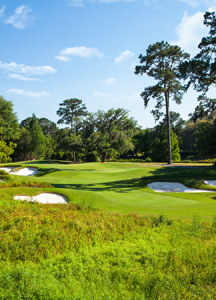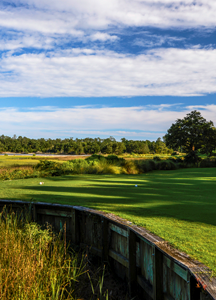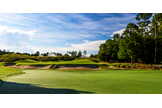Myrtle Beach
Published:
Stand on the tee of Glen Dornoch’s par-3 17th and you learn exactly what golf in Myrtle Beach is all about. Hitting you like a four-club wind is a panorama of forest, sky and expansive, buzzing marshland. Pleasure boats drift past on the hazy Intracoastal Waterway while above, red-tailed hawks mew. Somewhere in the middle of all this, 170 yards distant, is an immaculate green. Deep and narrow, and protected by a series of moon-crater bunkers, its blue-flagged pin waits more in hope than expectation. Target golf against a beautiful, natural backdrop is the name of the game in Myrtle Beach. It’s true that despite the region’s name, that backdrop is rarely the Atlantic; indeed, of the 101 courses the area boasts, the par-3 9th of the Dunes Club is one of the very few views the golfer gets of the epic, south-east coastal sweep known as the Grand Strand. Yet the ubiquitous marshland and the thousands of towering live oak trees, often draped in frozen waterfalls of Spanish moss, give this low-country landscape an appeal that rivals cliff and beach.
The Myrtle Beach area itself stretches some 30 miles along the northern portion of South Carolina’s seaboard. Route 17 runs north-south through the region, conveniently linking many of the courses, and finding your way around – not always easy in the States – is mercifully simple. The compact nature of the town not only gives Myrtle Beach the comfortably intimate feel of a golfing town – it also gives you terrific options. You can, for example, play Glen Dornoch, at the northern tip, in the morning, and Caledonia, at the southern end in the afternoon.
Glen Dornoch itself – we can instantly park any similarities with Dornoch, or indeed any signs of a Glen – epitomises the Myrtle experience. Both nines weave through thick forest, fairways and greens subtly defended by marshy ditches and lakes, before emerging gloriously at the wide open spaces bordering the Intracoastal Waterway – an inland water route that in fact renders Myrtle Beach an island. The coast may be two miles away; it hardly matters.
Meanwhile, Caledonia is considered one of Myrtle Beach’s finest tracks, As you head up its oak-framed drive to a pristine and elegant colonial clubhouse, it’s not hard to imagine you are arriving at a version of Augusta National; immaculate maintenance and landscaping does little to break the spell. The course itself at times approaches fantasy golf, a stunning sequence of fleeting, sinuous fairways leading to perfectly sited greens protected by pond, branch and sand.
It demands strategy and accuracy but the Mike Strantz test is never less than fair and exhilarating… especially at the climax. For as you reach the 16th tee, you start to hear cheers ahead. The clubhouse deck overlooks the water-guarded 18th green and you will have a demanding gallery for your final approach. Position your tee shot to the right and you can leave as little as 140 yards in… giving you the chance to create your own moment of glory. Across the road, Caledonia’s sister course, True Blue is the perfect accompaniment. Yawning expanses of fairway give you the chance to open your shoulders, while the many sandy waste areas aren’t especially penal and amplify the visual appeal. As with Caledonia, one picturebook hole follows another, right from the opener – an epic, sweeping 600-yard par 5 with an unmissable fairway and an unhittable green.
Almost midway between True Blue and Glen Dornoch is the course that triggered the Myrtle Beach golf boom. “The Dunes Club was built by Robert Trent Jones in 1949,” says Chris King, communications director for Myrtle Beach Golf Holiday. “It put the place on the map. It’s hosted six senior PGAs, a US Women’s Open, the finals of Q school, and the PGA Professional National Championships.”
The course itself doesn’t exactly run along the Ocean front, but the clubhouse is there. The course itself has much more natural movement and elevation than others in the area, and offers Ocean glimpses. But the course is considered a classic of architecture, and should be on anyone’s Myrtle itinerary. Myrtle Beach’s big rival is, of course, Florida. With prestigious resorts like Bay Hill and Doral, and direct flights from the UK (Myrtle Beach needs a switch at Charlotte or Atlanta), it would seem to have the edge. King sees things very differently.
“To start, no destination in America can compete with the quality and quantity of our golf offerings,” he argues. “We have 13 of the top 100 public courses in America. The likes of Caledonia, True Blue, Heritage, TPC Myrtle Beach, Barefoot’s four courses… Tidewater is for many the prettiest course of them all. These are all exceptional venues.
“Then there is value. Bay Hill may offer more prestige than a place like Caledonia, but it’s not regarded as a better golf course. Try putting together a package for four nights and rounds in April at both venues; you’ll find Caledonia substantially cheaper.
“But above all,” he adds, “Myrtle Beach is a golf town. Everyone here is invested and interested in golf. Myrtle Beach feels like a golfing community. It’s an easier place to get what you want out of a golf holiday.
“But underpinning it all is the quality of the courses. When you leave other destinations, you can wind up talking about the sights or the entertainments; when you leave Myrtle Beach, you’re talking about the golf.”



Selected Star Courses |
|
Off-course Highlights |
|
Where to stay |
|
Myrtle Beach is the home of the golf package, with 60 golf break companies in the area and a wide source of accommodation, from coastal retreats to stay and plays. Your first port of call is www.myrtlebeachgolfholiday.com but also consider:
|
Where to eat |
|
To the south end of Myrtle Beach, Bistro 217 on Pauley’s Island offers superior American fayre including braised ribs and local flounder. More central are New York Prime, which has developed a reputation for the area’s best steak, and Aspen Grille. Right on the coast, the charming Sea Captain’s House is the place for superb seafood. |
When to go |
|
Myrtle Beach’s peak seasons are April and October, when humidity is low and the region averages 76º. There are deals to be had in high summer, if you don’t mind the 91º average and sweltering humidity. September perhaps offers the best trade-off, with the summer humidity broken and temperatures averaging 85ºC. It is the Atlantic hurricane season, but stats show you’d be unlucky to catch one. The winter average is 54º. |

